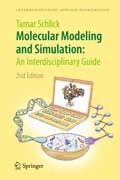
This book evolved from an interdisciplinary graduate course entitled Molecular Modeling developed at New York University. Its primary goal is to stimulate excitement for molecular modeling research while introducing readers to the wide range of biomolecular problems being solved by computational techniques andto those computational tools. The book is intended for beginning graduate students in medical schools and scientific fields such as biology, chemistry, physics, mathematics, and computer science. Other scientists who wish to enter, or become familiar, with the field of biomolecular modeling and simulation may also benefit from the broad coverage of problems and approaches. The book surveys three broad areas: biomolecular structure and modeling: current problems and state of computations; molecular mechanics: force field origin, composition, and evaluation techniques; and simulation methods: geometry optimization, Monte Carlo, and molecular dynamics approaches. Besides small additions and revisions made throughout the text and displayed materials to reflect the latest literature and field developments, some chapters have undergone more extensive revisions for this second edition. The book has been updated throughout, in particularly changes include: Chapters 1 and 2 that provide a historical perspective and an overview of current applications to biomolecular systems have beensubstantially updated; Chapter 4 which reflects modified protein classification with new protein examples and sequence statistics; the chapter Topics in Nucleic Acids (now expanded into two chapters, 6 and 7, which includes recent developments in RNA structure and function; the force field chapters 4--6, whichcontain new sections on enhanced sampling methods; Chapter 15 which includes an update on pharmacogenomics developments. 'Molecular modeling is now an important branch of modern biochemistry. Schlick has brought her unique interdisciplinary expertise to the subject. One of the most distinguished characteristics of the book is that it makes the reading really fun and the material accessible. a crystal clear logical presentation . Schlick has added a unique title to the collection of mathematical biology textbooks . a valuable introduction to the field of computational molecular modeling. It is a unique textbook .' (Hong Qian, SIAM Reviews, Vol. 47 (4), 2005)." Very broad overview of the field intended for an interdisciplinary audience Lively discussion of current challenges written in a colloquial style Author is a rising star in this discipline Suitably accessible for beginners and suitably rigorous for experts Features extensive four-color illustrations Appendices featuring homework assignments and reading lists complement the material in the main text INDICE: Biomolecular Structure and Modeling: Historical Perspective.- Biomolecular Structure and Modeling: Problem and Application Perspective.- ProteinStructure Introduction.- Protein Structure Hierarchy.- Nucleic Acids Structure Minitutorial.- Topics in Nucleic Acids Structure.- Theoretical and Computational Approaches to Biomolecular Structure.- Force Fields.- Nonbonded Computations.- Multivariate Minimization in Computational Chemistry.- Monte Carlo Techniques.- Molecular Dynamics: Basics.- Molecular Dynamics: Further Topics.- Similarity and Diversity in Chemical Design.- Epilogue.- Appendices.- Index.
- ISBN: 978-1-4419-6350-5
- Editorial: Springer
- Encuadernacion: Cartoné
- Páginas: 690
- Fecha Publicación: 29/05/2010
- Nº Volúmenes: 1
- Idioma: Inglés
